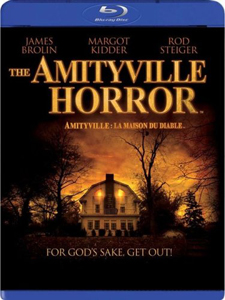“The Amityville Horror” (1979) tells the most famous case investigated by Ed and Lorraine Warren. It’s not all that different from their other cases, but it’s the most well-known because of the name recognition of the 1977 book by Jay Anson and this film adaptation.
The demonologists don’t appear, nor are they mentioned, but “Conjuring” fans on a Warrens kick will want to see how the “Warrens expanded universe” started. The duo’s investigations into the Lutz hauntings – and that of the previous occupants, the DeFeo family – are briefly touched on at the start of “The Conjuring 2.”
“The Amityville Horror” sits in a middle ground among horror classics. It’s the worst horror movie to ever launch 50-plus follow-up films, short films and novels. (Because Amityville is a real village on Long Island, it can’t be copyrighted.) But it’s also the best film to ever launch such an absurd amount of material. And rankings/ratings/reviews indicate it’s better than 95 to 100 percent of what it wrought.

“The Amityville Horror” (1979)
Director: Stuart Rosenberg
Writers: Sandor Stern, based on the book by Jay Anson
Stars: James Brolin, Margot Kidder, Rod Steiger
On Tuesdays this summer, RFMC is looking back at selected films in the “Amityville” series.
‘True’ story sets it apart
Unlike some other Seventies horror classics, director Stuart Rosenberg’s film had a “cheesy” label for several decades, but its age has come around to serve it well due to nostalgia.
To watch it is to appreciate the 1970s, and the strong lead performances by James Brolin and Margot Kidder (fresh off “Superman”) as newlyweds George and Kathy Lutz. She comes packaged with two sons and a daughter from a previous relationship. The daughter, Amy (Natasha Ryan, who looks like later child-star icon Danielle Harris), is the classic kid with an “imaginary” friend that’s actually a ghost.
Setting “Amityville” apart from the 1970s horror pack, it’s based on a true (or supposedly true) story, whereas “The Exorcist” and “The Omen” were dreamt up by authors. The narrative starts with an excellent prolog that blends lightning strikes with shotgun blasts as it introduces a third “main character” – the house whose attic windows resemble demon eyes.
A son of the DeFeo family murders his parents and siblings “In Cold Blood”-style in 1974 in their oceanfront home. This part is true. The notion that he was possessed is in question (the justice system ruled that he was responsible for the murders). A year later, the Lutzes move in. This is true. And again, the subsequent haunting experience is in question.

Any horror-movie watcher will find the ensuing series of events to be old hat, things the Warrens traded in. The Lutzes get a great deal on the house because people died there. As always in this subgenre, they can’t easily leave once the hauntings start, the way a renter could.
Origin of those ‘damn enchiladas’
At 118 minutes, “Amityville” is long and sometimes clunky. In one (in)famous sequence, Father Delaney (Rod Steiger) enters a room with the intent of blessing it. The window is covered with flies, he feels ill and a voice orders him to get out. This would be hilariously parodied by James Woods in “Scary Movie 2’s” “damn enchiladas” scene. But the original scene overstays its welcome after making its point.
That said, Brolin and Kidder make “Amityville” better than a typical film with this plot. Brolin gives a blank turn, but not in a bad way – we can graft the weird and disconcerting events on to him. I imagined George — stressed by his struggling, ill-defined “business” — as being a disconnected father, and had to remind myself that he is a new stepfather. (Not an outwardly loving one, granted.)
Kidder is the wife who may or may not be crazy (although we know she is not, in this case), but again, not in a bad way. She’s cute and sympathetic, and she sells the material even when the practical effects are on the artificial side.
Questions go unanswered
A family friend, Helen Shaver’s Carolyn, is the closest we get to a Lorraine Warren stand-in, as she recognizes there’s something wrong about the house. Her research reveals the classic “ancient Indian burial grounds.” Meanwhile, Kathy goes through microfiche files to probe the past year’s murders. She finds that her husband looks exactly like DeFeo.
After an acceptable finale featuring rain, screaming and blood-oozing walls, “Amityville” abruptly ends as the Lutzes essentially say “screw this sh**” and depart, regardless of the stress of financial ruin. This is another way it’s different from the “Conjurings.” We don’t get the backstory of the demons/ghosts.
And it remains utterly inexplicable why George and the DeFeo killer look identical. “The Shining” (which also borrows the “husband’s ax through the door” image) would cheekily have fun with a similar twist a year later, but it’s presented so bluntly in “Amityville” that we expect an answer.
“The Amityville Horror” is a little bit classic, a little bit cheesy. It’s not a trope originator, but it is a trope codifier for the Warren-related films. It makes me want to cautiously wade deeper into the franchise.

